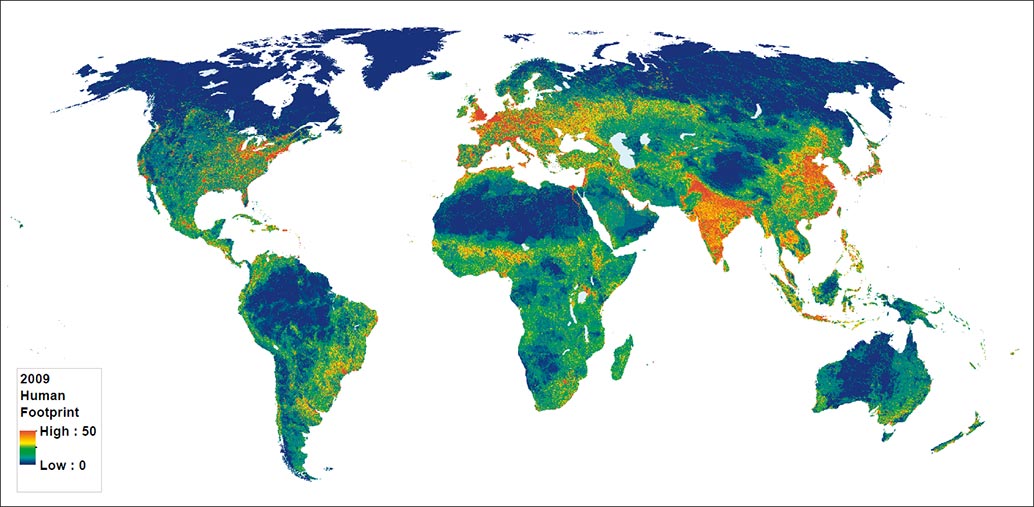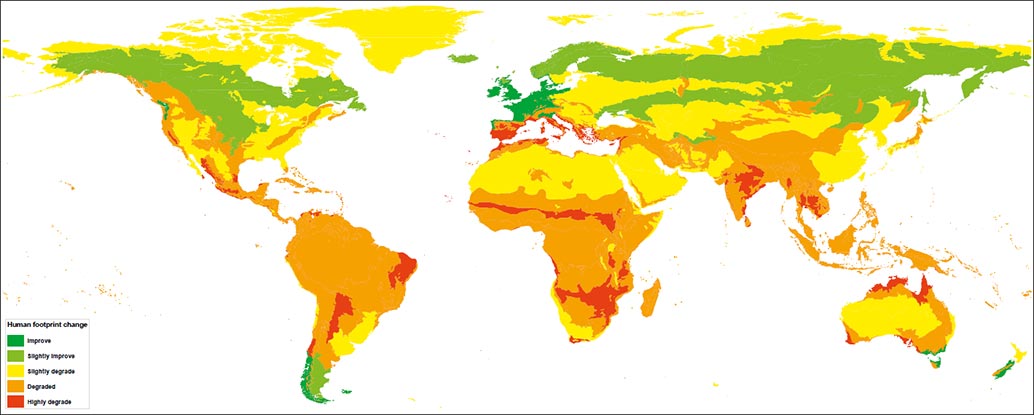The global human footprint – infrastructure, land cover and human access into natural areas – is expanding (Figure 6.5) (Venter et al. 2016). Economic drivers and demographic pressures are the primary sources of accelerating land-use change. These drive agricultural expansion – the largest contributor to land-use change – for food, commodities, fodder and biofuels (Alexander et al. 2015), demand for extraction of mineral, metal and energy resources (Mudd and Jowitt 2017), urbanization, road building, land-take and deforestation, land degradation, desertification and habitat fragmentation.
Urban growth is a major driver of land-use change and habitat loss through deforestation. In developing countries, the establishment and expansion of urban areas (many of which lack adequate planning) and the growth of infrastructure can coincide with biodiversity hotspots (UNEP 2016d). Road construction facilitates the spread of invasive species, and allows for easier access into previously intact habitats, exposing them to threats from hunting and resource exploitation (Alamgir et al. 2017). Additional land-use practices, such as burning (or the suppression of natural fire) (Smith et al. 2016) and livestock grazing, impose further pressures on already degraded systems (Royal Botanic Gardens Kew2010). The marine environment is equally affected and heavily impacted by commercial fishing practices, such as bottom trawling, coastal development and dredging (Ocean Health Index 2017) (see Chapter 7). International trade can export threats to biodiversity, resulting from demand in developed countries, to developing countries (Lenzen et al. 2012). Many of the causes of habitat destruction also contribute to human population pressure and movement, which further compound threats to biodiversity (Black et al. 2011) (see Chapter 2).


Pressure from agricultural land use is widely expected to increase (Kehoe et al. 2017). Global food production is forecast to rise by between 60 and 100 per cent by 2050 as a result of population growth and economic development, with an accompanying minimum net increase in land under crop production of 70 million ha (Tilman et al. 2011; Alexandratos and Bruinsma 2012) (see Chapter 8). Large-scale industrial agriculture has many unfavourable environmental and social effects, such as land degradation, albedo changes, increase in methane emissions and loss of carbon sequestration capacities (Laurance, Sayer and Cassman2014; Dangal et al. 2017; Houspanossian et al. 2017). Agricultural intensification can reduce pressure on non-agricultural lands (Phalan et al. 2016), but may have detrimental impacts on wild plant and animal species that cohabit within diverse agroecosystems (Emmerson et al. 2016).
Rapid development-induced impacts result from the construction of dams, mines and other hard infrastructure developments, including those associated with energy production (Butt et al. 2013).
Climate warming and increasing frequency of extreme weather events contribute to habitat loss and degradation (see Chapter 2). Warming seas are reducing sea ice extent (critical hunting habitat for polar bears, seals and fishing birds) (Intergovernmental Panel on Climate Change [IPCC] 2014, p. 80) and, in conjunction with elevated atmospheric CO2, acidifying ocean habitats (Hoegh-Guldberg et al. 2017). Extreme weather events, such as flooding, drought and fire, can accelerate the degradation of already vulnerable habitats (IPCC 2014, p. 294).
Land-use change, which may impact both aquatic and terrestrial environments, can result in: